The Dell XPS 13 (9300) Review: Return of the King
by Brett Howse on July 16, 2020 10:00 AM ESTWireless
Dell offers two wireless radio options for the XPS 13, and both are Killer-branded. The default wireless card is the Killer Wi-Fi 6 AX1650, which is a 2x2:2 wireless solution based on the excellent Intel AX200. If somehow you missed it, Intel recently acquired Rivet Networks, so the Killer brand should continue to provide the performance and stability of the Intel adapters for the foreseeable future. Dell also lists a second Killer AX500 Wi-Fi 6 option, but this Killer product is based on the Qualcomm 6390 Wi-Fi 6 chipset. Since Killer has been acquired, that part may not be around for much longer. Our review unit features the Intel-based AX1650.
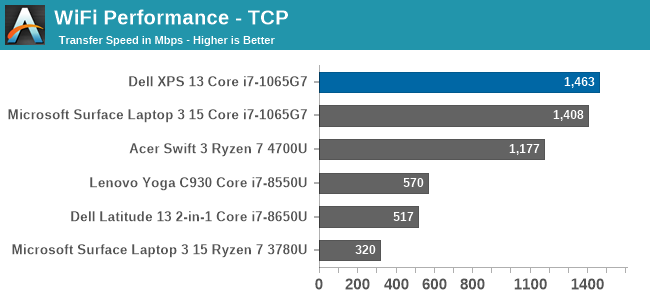
Performance is simply fantastic, and ever since Killer was able to base their network cards on Intel wireless, the stability concerns appear to be a forgotten memory. There was not a single time that the laptop had any issues with its network connection during any of the testing. That was certainly not the case on some of the older Qualcomm-based Killer products.
Audio
Dell offers Waves MaxxAudio Pro stereo speakers, at 2.5 Watts peak each, which are outfitted on the bottom of the laptops right on the edge of the device.
Sound quality is a bit on the tinny side, with not a lot of low end at all. The speaker setup does get quite loud though, with 83 dB(A) measured one inch over the trackpad at maximum volume. There was little to no distortion at peak volume either.
The dual-microphone array is found on the very top of the bezel, which would allow it to work with the device closed. It is a great way to hide the holes, with only the 2.25 mm 720p webcam showing in the bezel itself.
Thermals
Dell outfits the XPS 13 with dual fans and a single heatpipe to cool the 15-Watt Thermal Design Power of the Core processor under the hood. They have added hidden exhaust vents in the hinge, to allow more airflow without compromising the looks. There is also a layer of GORE thermal insulation under the keyboard, which helps keep that portion cool to the touch even under load.
To see how the XPS 13 performs under load, it was run at 100% for an extended period while monitoring the device.
This graph tells an interesting story, unlike most laptops we see. First, Dell has gone absolutely crazy with the PL2 level on the XPS 13, with a peak measurement of a whopping 42 Watts. But, that is not sustainable in a 13-inch laptop, and the CPU throttles in PL2 until it reaches the PL1 limit, which is right at 15 Watts in the XPS 13’s most performant mode. Most of the notebooks we have tested tend to allow a PL1 level above this, with maybe 20-21 Watts as a constant, but Dell clamps to 15 Watts, then spikes back up when the thermals allow, so we see this see-saw effect of the device running between 15 and 30 Watts. This is similar to how the XPS 13 2-in-1 behaved, and it would be nice to see the company address this with a more consistent power delivery under sustained load.
Over the duration of the test, the device averaged 18 Watts of draw, with an average CPU temperature of 80°C, with the four cores running at 2100 MHz. During this extended run, the noise level was very restrained, only hitting around 44 dB(A) measured about one inch over the trackpad. The GORE thermal insulation also did its job, with the keyboard deck remaining cool.
Software
Dell’s included software suite is a very polished set of applications, allowing the user to quickly get the device set up, adjusted, and of course, contact support. As with most manufacturers, they include a utility to get the latest updates, called Dell Update, and that includes some maintenance utilities as well.
Dell’s Power Manager software allows you to change the power profile, as well as adjust the battery charging. The Thermal Management tab allows you to pick a fan and CPU profile, or leave it as the default Optimzed setting which works well for most scenarios.
Dell offers a plethora of battery options to maintain and extend the life of the battery. Out of the box, it comes in an “Adaptive” setting which learns your usage patterns and tries to keep the battery at a good state of charge, but you can override that to keep the battery always at 100% charge in case you need it, or if you mostly use it on AC you can set it to keep the battery to a lower level of charge to prolong its life.
The days of laptops being saddles with an almost unending array of shareware and trial software seem to be mostly over, and even though Dell included Norton with the XPS 13, it can easily be removed if necessary.


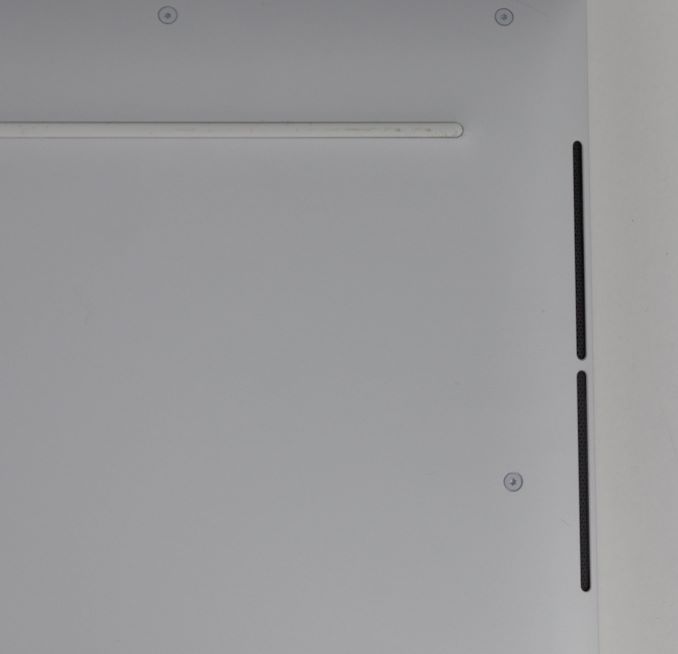
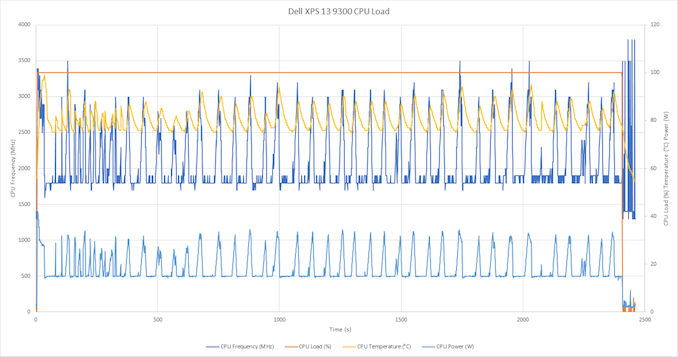
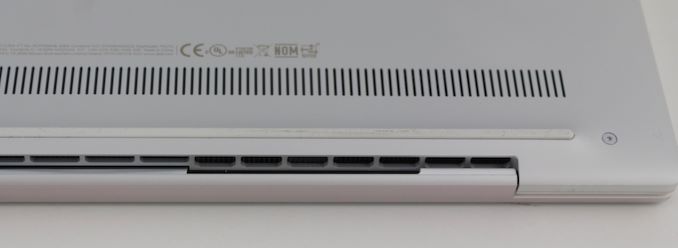

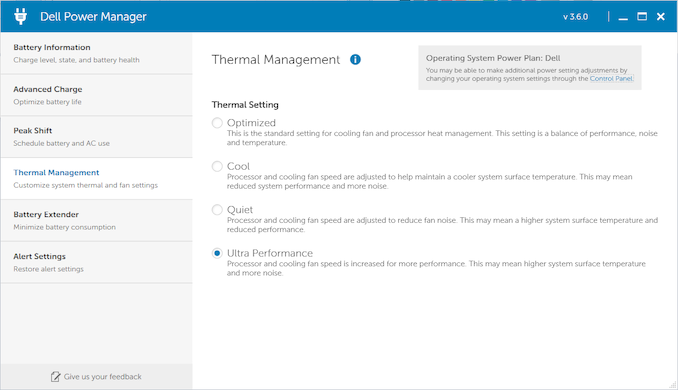
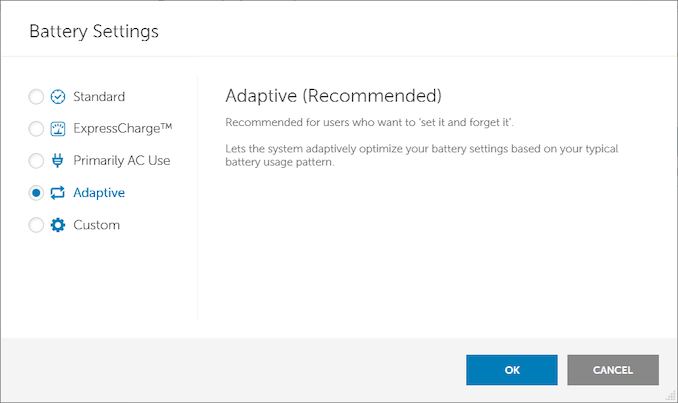








224 Comments
View All Comments
gescom - Friday, July 17, 2020 - link
You have a kind of sick desperation in your laugh.https://www.notebookcheck.net/Lenovo-ThinkPad-T14s...
Korguz - Friday, July 17, 2020 - link
gescom, more like a sick desperation to keep praising his god intel, and to bash amd any chance he can.ikjadoon - Thursday, July 16, 2020 - link
IIRC, this was not mentioned by Anandtech, but this laptop (and many, many, many, many) others from the premium Ultrabook category are partnered directly with Intel through the Project Athena program, aka the "Engineered for Mobile Performance" badge you sometimes see.It gives a lot of manufacturing / R&D support while also demanding a minimum set of specifications; I think, in the end, it's a win for OEMs as they get a better product (a virtuous cycle) and they get R&D support directly from Intel on the entire notebook (not just the CPU or wireless).
I think 9/10 premium Ultrabooks are Project Athena certified.
I do believe AMD has launched a rival program with Renoir, but it may take time to gain traction. Tiger Lake vs Zen3-based mobile is going to be exciting and AMD absolutely deserves far better than the relatively average performers they keep getting stuck with.
See Anandtech's reporting here: https://www.anandtech.com/show/14444/intels-projec...
TheinsanegamerN - Thursday, July 16, 2020 - link
I've said for years that AMD needs to partner with a smaller brand like MSI or Clevo and show the world what a proper AMD notebook looks like.I was saying this back in the Llano days where nobody wanted to make a ultrabook style laptop with the A8-3500mx.
jeremyshaw - Thursday, July 16, 2020 - link
They did, with HP, a company with historically strong AMD ties in their consumer line. It didn't go well. Whomever thought bulldozer on netbooks was a good idea, is hopefully no longer calling shots at AMD or HP anymore.eastcoast_pete - Thursday, July 16, 2020 - link
I made the mistake of buying one, and it was bad. The sooner that whole period is buried and forgotten, the better for AMD.lmcd - Thursday, July 16, 2020 - link
If you're referring to the entire Bulldozer family history, I gotta say my Toshiba Satellite with an A8-4500M was actually pretty solid for a number of years. Yea the battery life was trash but performance held up for years, especially with dual-channel memory that I upgraded it to.drothgery - Thursday, July 16, 2020 - link
Depends what they think AMD and Intel will be offering next year, I'd imagine.Most vendors wouldn't have even started designing an AMD premium notebook until after they had real performance and power usage data on Ryzen 4xxx, and even then wouldn't bother unless they were fairly confident Intel wouldn't be able to match it fairly soon.
Cinebench multithread (and other embarrassingly parallel benchmarks) notwithstanding, there's really not much value in more than 4 core/8 threads for most consumers (servers and workstations are another matter); Amdhal's law is still real. But the optics of selling 4 cores vs 8 aren't great, and at least initially, Tiger Lake U will still be a quad core.
Spunjji - Friday, July 17, 2020 - link
"Most vendors wouldn't have even started designing an AMD premium notebook until after they had real performance and power usage data on Ryzen 4xxx"They would have had that data a long time before the platform shipped - Asus couldn't have designed the class-redefining Zephyrus 14 without it. They managed to create a whole new category of gaming sub-notebook, yet most of the larger OEMs couldn't manage to get one into an existing Ultrabook chassis. 🤔
Deicidium369 - Friday, July 17, 2020 - link
Yeah agree there - the OEMs have had access to the specifics of Renoir - but likely will repurpose previous designs, since Renoir is largely like the previous (3xxx APUs, don't know the names) - from an electrical and packaging point of view.I can't imagine having a laptop as a gaming platform - Opus Magnum maybe - but not BF5. But every use case is different - there used to be a DTR slot in my lineup - but not any more.